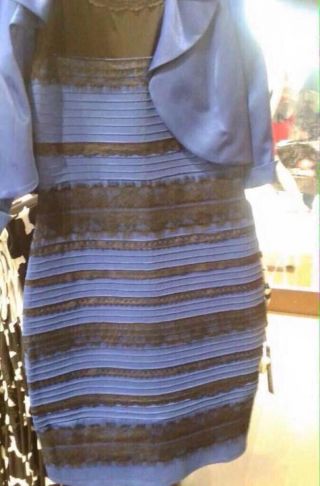What color is that dress, indeed?
In the end, it really matters what tetrachromats say. And interestingly, while "normal" viewers are still debating the colors, three of we superseers essentially agree on the tones-- none of which are exactly the black and blue, blue and gold, white and gold, or blue and brown being discussed. The dress is a fascinating retinal Rorschach test but one must consider the limitations of trichromatic, or “normal” vision.
About 18 months ago, a DNA test showed that I have an extra class of cones for color vision. Most people have three: red, green, and blue. My extra class is yellow, giving me a potential spectrum 100 times richer than usual. Normal trichromats are believed to see a million colors. I see up to 100 million and so do a handful of other women beginning to be identified.
Tetrachromats are always women as it requires two X-chromosomes. And we are used to debating color because almost nothing normal people describe as “red” or any other shade seems true enough to our discerning eyes.
What color is the dress for me? And by that I really mean what color is the image of the dress? Periwinkle and bronzy brown in the light shown, though I would also like to see it in person and in natural light to be certain. So I’m on team “light blue and brown” but dissatisfied with the lack of specificity in the shades of blue and brown offered.
Here are my color swatches compared to the dress to show the subtleties:

I checked in with two of my fellow superseers—the interior designers Megan Arquette of Los Angeles and Susan Hogan of Pittsburgh—for their expert opinions.
“It's all about the lighting!” said Ms. Hogan. “In brighter light, I see copper-gold and pale lavender-white. If you tilt the laptop screen back (reducing the amount of light), the dress appears blue and black to me.”
Megan Arquette agrees and also had thoughtful observations about light: “I can't judge the dress unless I see it. In front of me. The image isn't the actual dress. The image reads periwinkle and bronze. By the way, snow, even when one sees it in person, looks blue or purple in the shade.”
That’s three superseers with similar reactions.

This all reminds me of the philosopher Frank Jackson, who put forth a Knowledge Argument about color using a now-famous example of the neurophysiologist, Mary:
“Mary is a brilliant scientist who is, for whatever reason, forced to investigate the world from a black and white room via a black and white television monitor. She specializes in the neurophysiology of vision and acquires, let us suppose, all the physical information there is to obtain about what goes on when we see ripe tomatoes, or the sky, and use terms like ‘red,’ ‘blue,’ and so on. She discovers, for example, just which wavelength combinations from the sky stimulate the retina, and exactly how this produces via the central nervous system the contraction of the vocal chords and expulsion of air from the lungs that results in the uttering of the sentence ‘The sky is blue’.… What will happen when Mary is released from her black and white room or is given a color television monitor? Will she learn anything or not? It seems just obvious that she will learn something about the world and our visual experience of it. But then is it inescapable that her previous knowledge was incomplete. But she had all the physical information. Ergo there is more to have than that, and Physicalism is false.”

So while the matter of the dress on one level is so much chatter, people may be responding to the more profound philosophical question about qualia, or the subjective, qualitative properties of experiences.


